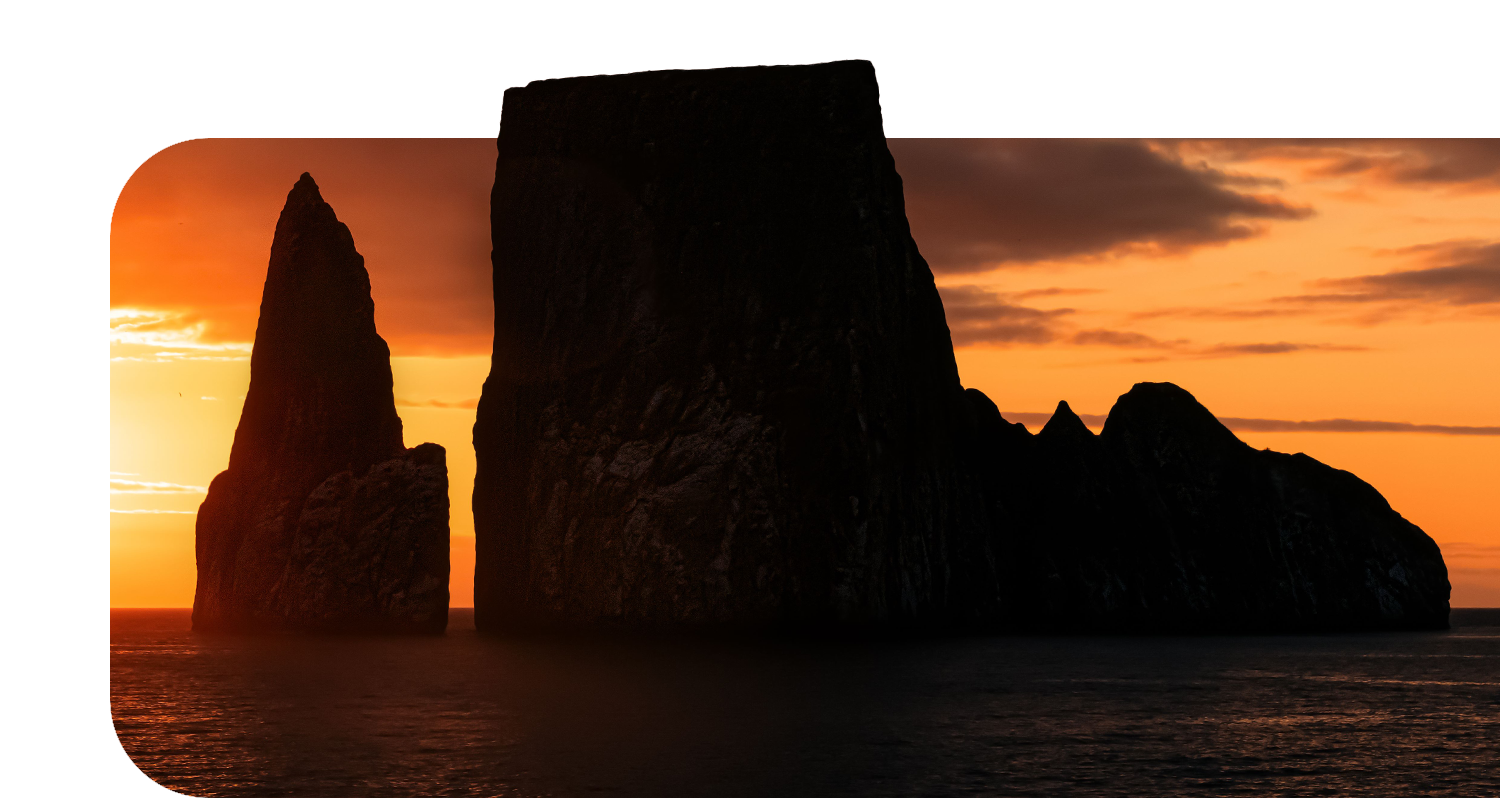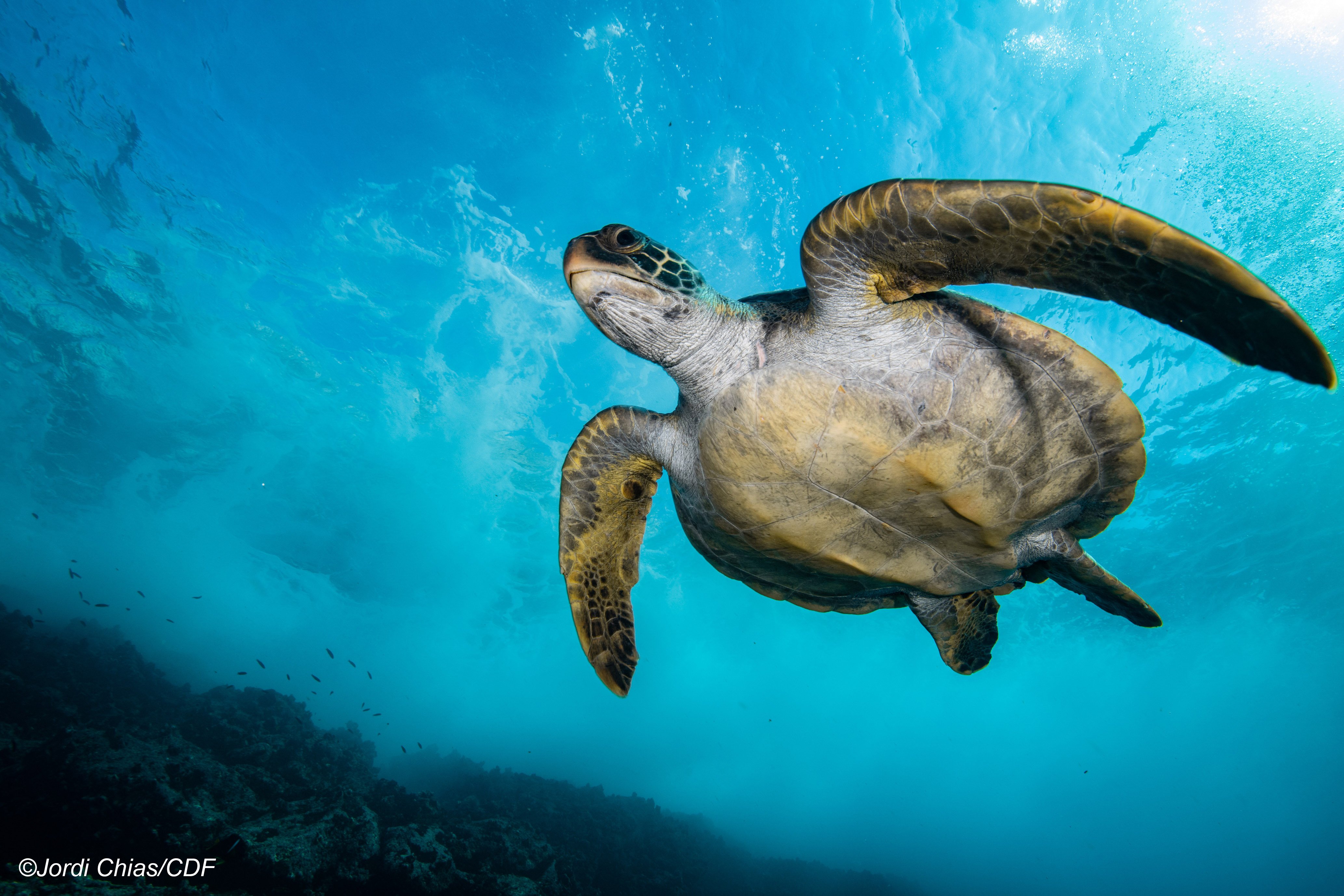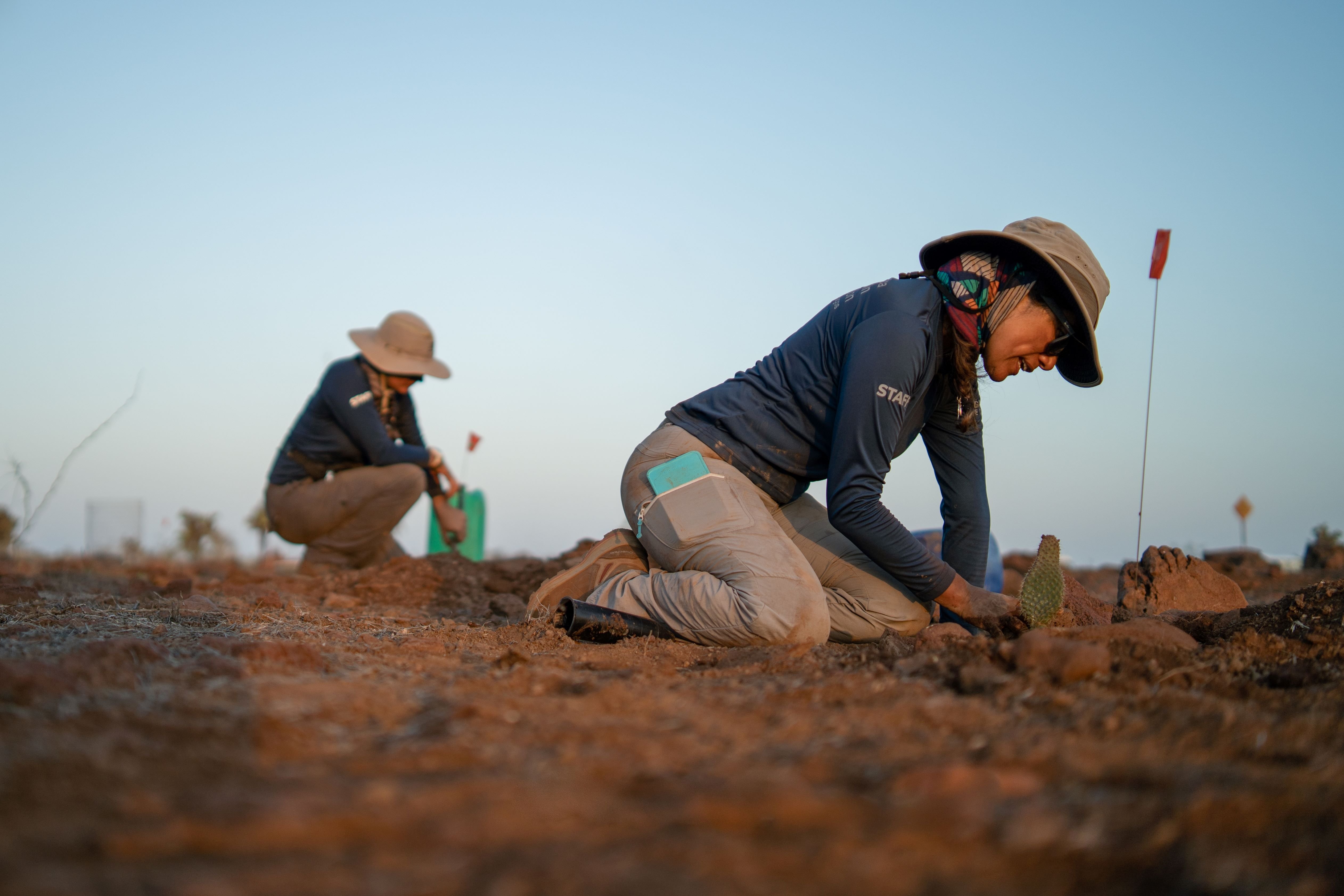Donate
Together, we can ensure that the Galapagos Islands remain a beacon of biodiversity and scientific inspiration.

Discover our work conserving key marine species in Galapagos and the Eastern Tropical Pacific.
View our Ocean Programs Deep-ocean exploration & conservation Mangrove Ecology and Climate Change Marine biodiversity research Marine bird conservation Ocean governance Sea turtle conservation Shark ecology and conservationExplore our efforts to safeguard and restore the Galapagos Islands' iconic land-based fauna and flora.
View our Land Programs Conservation of threatened plant species Control of the avian vampire fly Floreana Ecological Restoration Project Giant tortoise conservation Landbird conservation Restoration of Arid Zones Scalesia forest restorationUnderstand how our work is grounded in the benefits nature provides to the people of Galapagos.
View our people programs Education and Community Outreach Sustainable fisheries Sustainability for Conservation Urban and rural restoration
Make a lasting impact in Galapagos. Donate to support our mission and our work.
Donate Give monthly Adopt a speciesThere are a number of other ways you or your organization can contribute to our work.
Leave a legacy gift Become a corporate donor Fundraise for GalapagosThe impact you make in Galapagos is part of a larger footprint. Get involved today.
Meet our donors Become a CDF Ambassador Become a volunteer Send a free e-card! Sign up to our newsletter
Discover how our science and conservation programs are making a difference for the future of Galapagos.
View moreThe latest news releases from the Charles Darwin Foundation and its Research Station.
View moreExplore firsthand accounts from our researchers, staff, and collaborators in Galapagos.
View more
When you travel to Galapagos, you become part of a global effort to protect these iconic islands.
About Galapagos Travel tips How to pack for Galapagos Frequently Asked Questions Galapagos National Park Rules

Discover our work conserving key marine species in Galapagos and the Eastern Tropical Pacific.
View our Ocean Programs Deep-ocean exploration & conservation Mangrove Ecology and Climate Change Marine biodiversity research Marine bird conservation Ocean governance Sea turtle conservation Shark ecology and conservationExplore our efforts to safeguard and restore the Galapagos Islands' iconic land-based fauna and flora.
View our Land Programs Conservation of threatened plant species Control of the avian vampire fly Floreana Ecological Restoration Project Giant tortoise conservation Landbird conservation Restoration of Arid Zones Scalesia forest restorationUnderstand how our work is grounded in the benefits nature provides to the people of Galapagos.
View our people programs Education and Community Outreach Sustainable fisheries Sustainability for Conservation Urban and rural restoration
Make a lasting impact in Galapagos. Donate to support our mission and our work.
Donate Give monthly Adopt a speciesThere are a number of other ways you or your organization can contribute to our work.
Leave a legacy gift Become a corporate donor Fundraise for GalapagosThe impact you make in Galapagos is part of a larger footprint. Get involved today.
Meet our donors Become a CDF Ambassador Become a volunteer Send a free e-card! Sign up to our newsletter
Discover how our science and conservation programs are making a difference for the future of Galapagos.
View moreThe latest news releases from the Charles Darwin Foundation and its Research Station.
View moreExplore firsthand accounts from our researchers, staff, and collaborators in Galapagos.
View more
When you travel to Galapagos, you become part of a global effort to protect these iconic islands.
About Galapagos Travel tips How to pack for Galapagos Frequently Asked Questions Galapagos National Park Rules

Discover our work conserving key marine species in Galapagos and the Eastern Tropical Pacific.
View our Ocean Programs Deep-ocean exploration & conservation Mangrove Ecology and Climate Change Marine biodiversity research Marine bird conservation Ocean governance Sea turtle conservation Shark ecology and conservationExplore our efforts to safeguard and restore the Galapagos Islands' iconic land-based fauna and flora.
View our Land Programs Conservation of threatened plant species Control of the avian vampire fly Floreana Ecological Restoration Project Giant tortoise conservation Landbird conservation Restoration of Arid Zones Scalesia forest restorationUnderstand how our work is grounded in the benefits nature provides to the people of Galapagos.
View our people programs Education and Community Outreach Sustainable fisheries Sustainability for Conservation Urban and rural restoration
Make a lasting impact in Galapagos. Donate to support our mission and our work.
Donate Give monthly Adopt a speciesThere are a number of other ways you or your organization can contribute to our work.
Leave a legacy gift Become a corporate donor Fundraise for GalapagosThe impact you make in Galapagos is part of a larger footprint. Get involved today.
Meet our donors Become a CDF Ambassador Become a volunteer Send a free e-card! Sign up to our newsletter
Discover how our science and conservation programs are making a difference for the future of Galapagos.
View moreThe latest news releases from the Charles Darwin Foundation and its Research Station.
View moreExplore firsthand accounts from our researchers, staff, and collaborators in Galapagos.
View more
When you travel to Galapagos, you become part of a global effort to protect these iconic islands.
About Galapagos Travel tips How to pack for Galapagos Frequently Asked Questions Galapagos National Park Rules
Together, we can ensure that the Galapagos Islands remain a beacon of biodiversity and scientific inspiration.
If you are based in the U.S. and wish to make a donation via check, you can address it to the Friends of the Charles Darwin Foundation and send it to:
3630 Hill Boulevard, Suite 202, Jefferson Valley, NY 10535
To gift stock, please refer to the following details:
Please inform us at fundraising@fcdarwin.org.ec.
You can make a bequest addressed to the Charles Darwin Foundation or to the Friends of the Charles Darwin Foundation (if a U.S. tax-deductible receipt is required).
Download a document with a suggested charitable bequest language.
Tax-deductible donations for U.S. donors can also be made via wire transfer to the Friends of the Charles Darwin Foundation for the Galapagos Islands bank account in the U.S. If you would like to select this option, please contact us at fundraising@fcdarwin.org.ec
For donations from Ecuador, you can also make a direct transfer to our bank account with the Banco del Pacífico. If you would like to select this option, please contact us at fundraising@fcdarwin.org.ec
Donations from other countries can also be received directly at the Charles Darwin Foundation’s bank account with Kleinwort Hambros Bank Ltd. in London, United Kingdom. If you would like to select this option, please contact us at fundraising@fcdarwin.org.ec
Many Charles Darwin Foundation supporters give through a donor-advised fund (DAF)—a charitable investment account that makes it easy to support conservation while reaping significant tax benefits.
If your DAF is with Fidelity, Schwab, or BNY Mellon, you can recommend a gift to the Friends of the Charles Darwin Foundation using the DAF Direct form.
Your advisor can also mail the grant with your name, contact information, and a check payable to the Friends of the Charles Darwin Foundation for the Galapagos Islands to the following address:
3630 Hill Boulevard, Suite 202, Jefferson Valley, NY 10535
Our tax identification number (EIN) is 86-2660112.

All donations support the operations of the Charles Darwin Research Station in Galapagos. With more than 25 projects and over 100 scientists and staff, each donation, no matter the amount, represents an important contribution to our work.
Yes, the Charles Darwin Foundation works with the Friends of the Charles Darwin Foundation, which is a 501(c)(3) tax-exempt organization. All gifts made through our website can be deducted from your taxes. You will be provided with a gift acknowledgment that shows the amount and date of your tax-exempt donation.
You can also send a check, make a gift of stock, transfer funds electronically, include Friends of the Charles Darwin Foundation in your charitable estate plans, and much more. Please contact us at fundraising@fcdarwin.org.ec if you would like to learn more about any of these options.
Yes, all donations made through our website are securely processed by Fundraise Up, a digital giving platform that partners with many impactful non-profits around the world and integrates various payment methods, including PayPal, Google Pay, Apple Pay, payment by credit and debit cards (through Stripe), and even crypto payments (through Gemini wallet).
Yes, to set up a recurring donation online, please choose the “Monthly” option upon checkout. If you choose to give monthly, you will become a member of our Wild Club.
Of course! If you donate online, you will be asked to provide us with their name upon checkout. If you donate in honor of someone, please provide us with their email address so we can inform them of your donation. If you choose to use a different payment method, please make sure you attach the details of the honoree.
Upon making your first donation to the Charles Darwin Foundation online, you will gain access to a Donor Portal, where you can see your donation history, manage your fundraisers, and pause, cancel, or adjust recurring gift plans. You can access your Donor Portal by clicking “Manage my donation” in a thank you note you received upon making a gift.
If you donate online, Fundraise Up charges a small fee of 2.75% on each gift. Additionally, a small fee is charged by Stripe, depending on your payment method:
You can choose to cover these fees upon checkout, in which case your entire donation comes to the Friends of the Charles Darwin Foundation and subsequently to the Charles Darwin Foundation.
If you donate using any other method (e.g., check, stock, wire transfer), no fees will apply.
For online donations, an acknowledgment email containing a gift receipt attachment will be sent to you within a few minutes of donating. If you would like to request an acknowledgment reissue for a previous gift, please contact us at fundraising@fcdarwin.org.ec.
For other gifts made to the Friends of the Charles Darwin Foundation, an acknowledgment will be mailed within two weeks of our receipt of your donation.
To receive updates, please regularly check out the blog section on our website and follow us on our social media (Instagram, Facebook, Twitter, LinkedIn, YouTube).
If you make a donation of $5,000 or more, we can send you personalized updates and you can have direct access by phone and email to your personal Charles Darwin Foundation liaison.
The Charles Darwin Foundation offers volunteering opportunities at the Charles Darwin Research Station and sometimes even remotely. For more information visit our volunteer webpage.

You can support our work by becoming a custodian of one of the Galapagos Islands' most iconic species! Learn more about Galapagos giant tortoises, the endangered Little Vermilion Flycatcher, and many other unique species.

You can help inspire others to protect and preserve the wildlife and ecosystems of Galapagos. From donating for your birthday to running a marathon, or organizing a garage sale. There’s no limit to how you can get involved!

The impact you make on this small ecosystem of enormous biodiversity is part of a larger footprint you are leaving for the world's future. Join us on our mission to safeguard one of our planet’s most important natural treasures through science and conservation action by making a donation today. Thank you for making an impact with us.